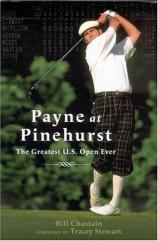Payne at Pinehurst: The Greatest U.s. Open Ever
Review
Payne at Pinehurst: The Greatest U.s. Open Ever
My initial response when Bill Chastain's PAYNE AT PINEHURST: The
Greatest U.S. Open Ever arrived on my desk was to scoff at the
hyperbolic claim of the title. Had Chastain forgotten the Open of
1913 at The Country Club in Brookline when amateur Francis Ouimet
upset the greatest golfers of his era and put golf on the map in
America? Had he considered Ben Hogan's miraculous comeback from
near death in winning the 1950 Open at Merion? What about 1960, at
Cherry Hills in Denver, when Arnold Palmer came from 7 strokes back
in the final round and secured victory in an Open that had a
half-dozen potential winners, including a young Jack Nicklaus and
an aging Ben Hogan. To put it bluntly, Chastain had a lot of
convincing to do with this reader.
Having now read the saga of the 1999 U.S. Open, the first held at
the famed Pinehurst No. 2, I must admit that a strong argument has
been made by Chastain. PAYNE AT PINEHURST is much more than the
accounting of a golf tournament. It is a complete and thorough
account of the Open beginning with Payne Stewart's loss at the
Olympic Club in San Francisco the previous year. Stewart led the
tournament after three rounds by four strokes, but Lee Janzen
overcame that deficit to win his second Open. The story of the 1999
Open began with Stewart's response to his defeat. He handled it
with grace and dignity. Stewart seemed to have matured as a golfer.
He would build on the lessons learned from defeat to better prepare
for the challenge of the next Open.
A golf tournament is far more than the events that transpire during
tournament week. The United States Golf Association selects
tournament venues and prepares courses with great care, planning
and precision. One constant at each year's event is that the
players complain about course conditions. For the 1999 Open there
was great concern about how the course would be set up for the
golfers and whether the conditions would detract from the quality
of play. Pinehurst No. 2, designed by architectural legend Donald
Ross, was a vastly different course from the typical USGA choice
for the Open. The greens at Pinehurst were crowned greens and could
not play at the speed preferred by the USGA. Southern summer heat
in North Carolina would make growing the rough to USGA standards
more difficult. But history ultimately prevailed over these
concerns. "Pinehurst is the St. Andrews of America," announced USGA
executive director David Fay. "It's been a national treasure for
nearly a century. And it has certainly earned the right to host the
1999 U.S. Open."
The U. S. Open is unique in many ways. Perhaps its most endearing
quality is that any golfer with a verified low handicap and an
entry fee can attempt to qualify for the tournament. Each year a
small number of "Cinderella stories" qualify to play in the USGA's
most prestigious event. PAYNE AT PINEHURST is more than the story
of Payne Stewart's victory --- it is also the saga of other
lesser-known golfers and how they make this tournament truly an
open event.
When most golfing fans think of Payne Stewart, his unique attire is
probably the first thing that comes to mind. Unlike his fellow
professionals who favor traditional golf clothing, Stewart always
appeared in plus four pants and tam caps. On Sundays he outfitted
himself in clothing that matched the colors of the closest National
Football League Franchise. During the Open at Pinehurst he wore the
Carolina blue and white of the University of North Carolina.
Chastain makes it clear that underneath the unique clothing was a
golfer working hard to be a better person, seeking peace in his
life. Stewart had the courage to recognize his flaws, not only as a
golfer but also as a man. His victory at the Open was a tribute to
that effort.
Bill Chastain has done a superb job in presenting the events
surrounding the 1999 Open. Sadly the story has a tragic ending.
Shortly after his victory Payne Stewart perished in a plane crash.
PAYNE AT PINEHURST ends as a touching tribute to an individual who
matured as a golfer and as a man. While the 1999 U.S. Open may not
have been the greatest Open ever, through Chastain's effort it now
makes the short list.
Reviewed by Stuart Shiffman on January 14, 2011
Payne at Pinehurst: The Greatest U.s. Open Ever
- Publication Date: June 1, 2004
- Genres: Nonfiction, Sports
- Hardcover: 304 pages
- Publisher: Thomas Dunne Books
- ISBN-10: 031233009X
- ISBN-13: 9780312330095



